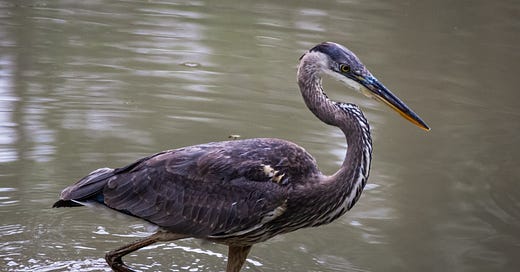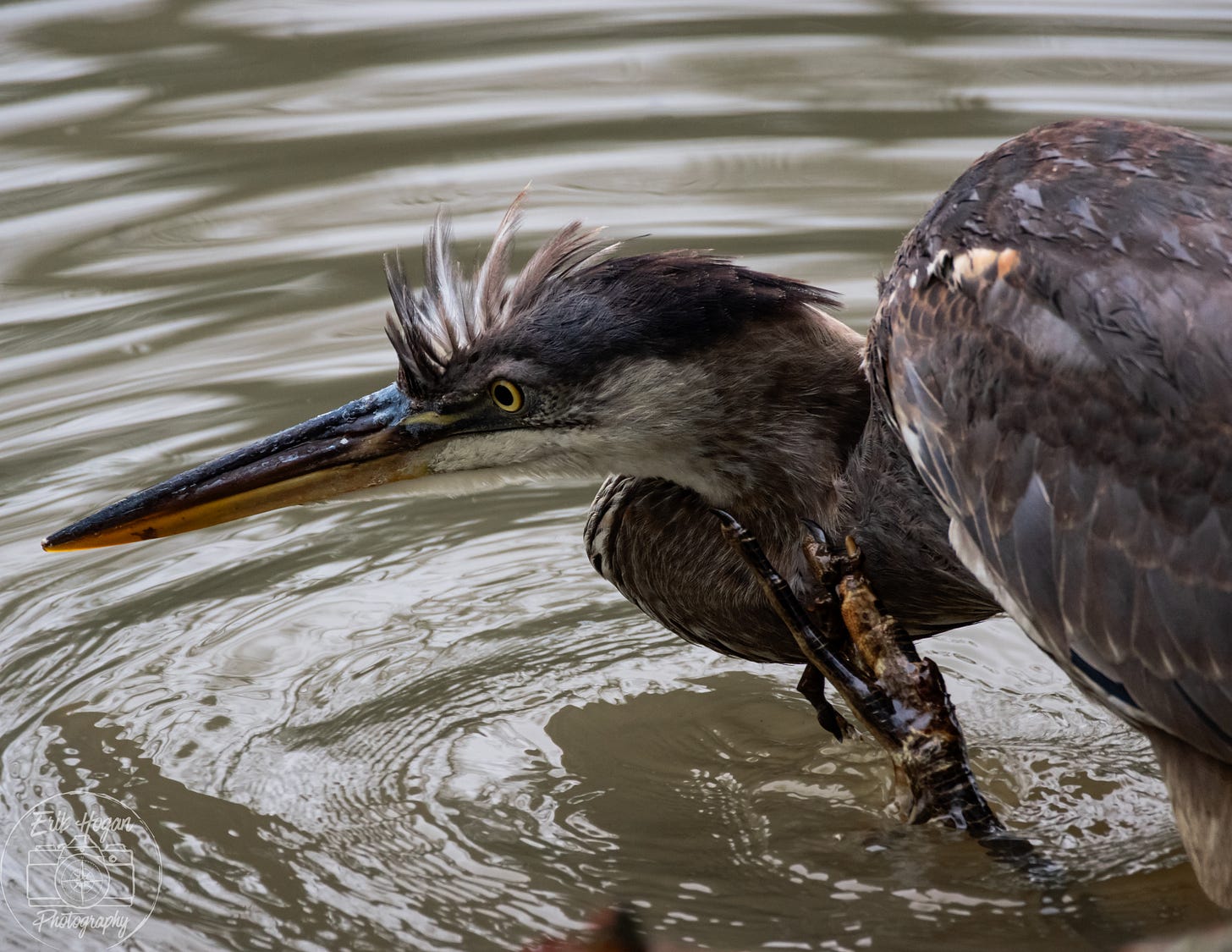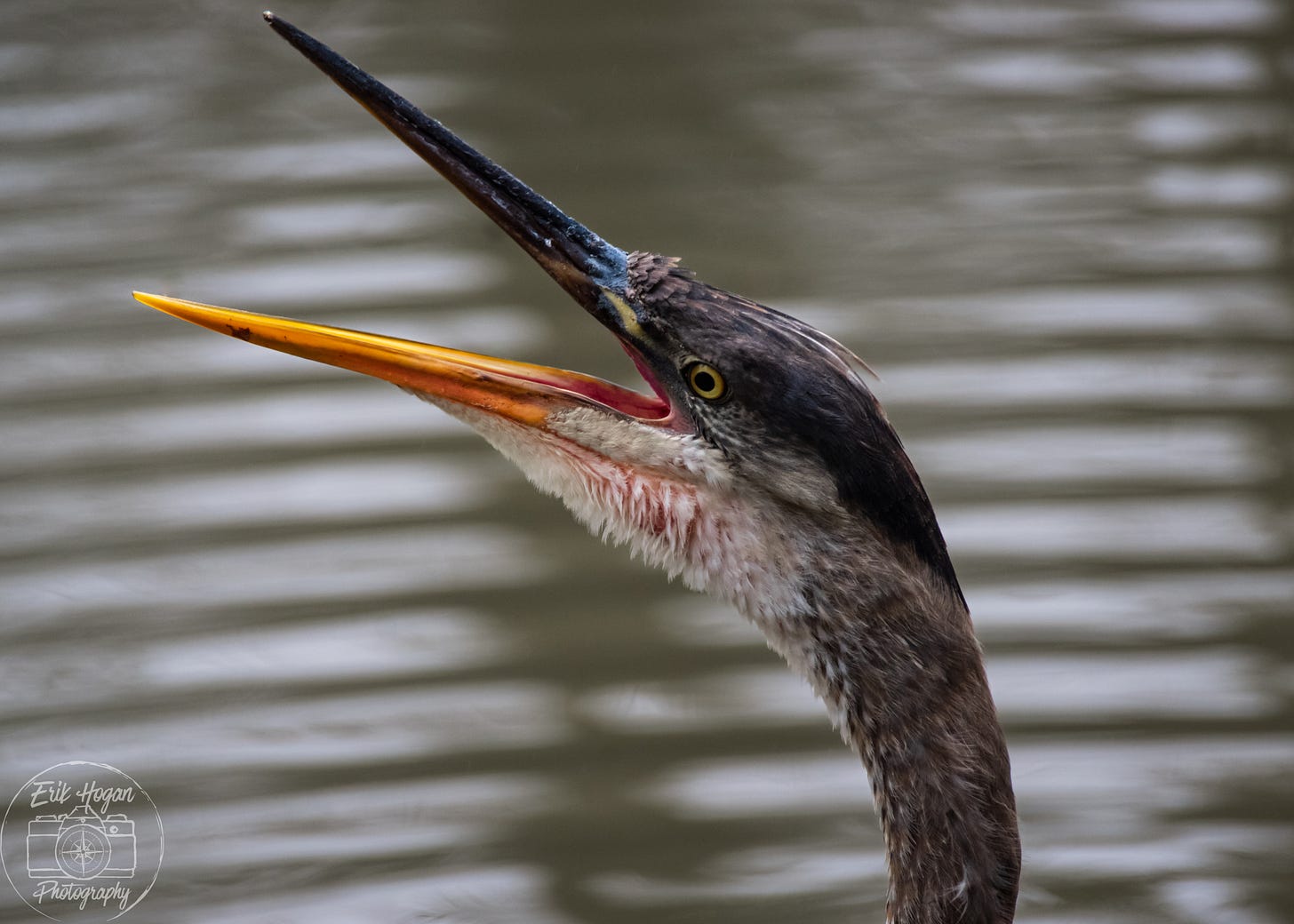Welcome to Field Notes!
This week we have another close study of local fauna, the Great Blue Heron. I was able to get close enough to this one for some interesting portrait shots!
If you are new here or missed it, this past week I finished up my first PDF ebook Field Notes: Adventure Stories Season I. I took adventure stories from this past year and re-worked them into a more readable ebook format. Some of these were split between two or three Field Notes issues and I partially re-wrote some which weren’t written in the more consistent style of my other adventure stories. As always, my photography is in there, as well!
Currently this ebook is only available to Field Notes subscribers. But, both Field Notes and the ebook are free, so why not?
Now, Lets Go!
Animals have an uncanny ability to detect movement, incongruous sounds, or even just sense when they are being watched. Even with a telephoto lens, clear and close photos of wildlife is a tough challenge.
Generally, there are two courses of action that can be taken to get them. The first is to sit and wait. By remaining still, sometimes for hours, one blends in with the surroundings and gives animals the opportunity to enter the area, unaware that they are already being watched. This is a common tactic of hunters, often aided by tree stands or blinds. The obvious downside to this method is a large commitment of time, with no guarantee that any creature will happen by.
My preferred method, and an important skill for any aspiring wildlife photographer, is the subtle art of creeping. Any time I walk in the forest, except perhaps if I’m exhausted from carrying a heavy load, I walk softly. I make every effort to be mentally present and aware of my footsteps, the sound and impact they make, and even the tracks I leave behind. This helps me to become part of the landscape, rather than something foreign just passing through. Physically, mystically, or a combination of both, this increases my odds of encountering animals.
As I discover an animal, I fully engage the creep. Animals are quick to sense fast motion and can hone in on the human form. I pause for several moments of stillness. Then, ever so slowly, I draw in my arms, stoop my shoulders, and crouch at the knees to condense my silhouette. Any camera manipulation must be done while minimally losing focus on the animal. A thorough knowledge of the camera and its functions is critical. Often it is important to move forward for a closer view or a different angle. Each step then becomes a slow motion act of muscular endurance and balance as the bottom of the foot gently rolls forward and body weight smoothly shifts onto it. The goal here is no sudden snaps, cracks, or thuds from the ground.
Even with engaged and meditative movement, it is common for animals to become startled and take flight. Every so often, though, there is creep success!
A huge form, slowly wafting through the sky on langorously flapping wings, the Great Blue Heron never fails to draw attention. Audubon states that it is the largest variety of Heron in North America. Yet it is a very common bird, often found stalking the edges of lakes or other shallow waterways, hunting fish with its sharply tapered beak. It wades in the water on Jurassic feet, twisting its serpentine neck as it hunts.
I saw this particular Blue Heron on the edge of a lake on an overcast morning in December. He had not yet noticed me, so I had the opportunity to retrieve my camera, attach my 55-300mm telephoto lens, and switch camera settings to shutter speed priority, all while out of view.
I wanted at least 1/400 sec shutter speed, if not faster, to freeze the bird’s motion without blur. It was a tough request on the cloudy day.
Once fully prepared, I was ready for the creep. Fortunately, part of my approach was across noiseless grass. Once I entered the leaves, their dampness from recent rains helped quiet my movement. I controlled my breathing, locked focus on the bird, and reduced my motions to an agonizing, imperceptible progression.
This heron was too busy to be concerned with me. He continued a nonchalant stroll along the shore, searching for his lunch. After photographing him for several minutes I relaxed my movement and, come to find out, this bird did not care! I walked and watched and took more pictures. He and I became acquainted until, lunch break over, he stretched his massive wings to propel himself to the other side of the lake. Regardless, I still count this as a successful creep!
I bet some of you are experienced creepers! Let me know what type of fauna you’ve been able to photograph and how you did it. I’d love to hear about it!
Remember, you can support Field Notes by sharing it, forwarding the emails, or just telling your friends. I’m thrilled that the community here is growing and spreading the word helps a lot!













I’m not a professional photographer or even a very good amateur one, but I do recognize “the creep.” I do this when kayaking (my favorite method of viewing wildlife), and it involves moving my paddle and boat as quietly as possible. I love being attuned to the sound, movement, and sight at the same time, and it frequently pays off. So many paddlers are focused on exercise or speed or play—I like that I focus on something quieter.
Sneaking up on wildlife is one the hardest parts of wildlife photography although without doubt the most important Erik! Thanks for the read.